Synthesis of Aminophenoxazinones and Evaluation of Their Phytotoxicity in the Search for New Natural Herbicides
Abstract
:1. Introduction
2. Materials and Methods
2.1. General Experimental Procedures
2.2. Synthesis of 2-Amino-3H-phenoxazin-3-one Derivatives (Compounds 1–6)
2.2.1. Synthesis of 2-Amino-3H-phenoxazin-3-one (Compound 1)
2.2.2. Synthesis of 2-Amino-3H-dipyrido [3,2-b:2′,3′-e][1,4]-oxazin-3-one (Compound 2)
2.2.3. Synthesis of 2-Amino-3-oxo-3H-phenoxazine-8-carboxylic acid (Compound 3)
2.2.4. Synthesis of 2-Amino-8-nitro-3H-phenoxazin-3-one (Compound 4)
2.2.5. Synthesis of 2-Amino-8-chloro-3H-phenoxazin-3-one (Compound 5) and 2-Amino-8-chloro-4-iodo-3H-phenoxazin-3-one (Compound 6)
2.3. Synthesis of 2,8-Diamino-3H-phenoxazin-3-one (Compound 7)
2.4. Wheat Coleoptile Bioassay
2.5. Phytotoxicity Bioassay
2.6. IC50 Calculation
3. Results and Discussion
3.1. Synthesis of APO and Its Derivatives
3.2. Phytotoxic Activity on Etiolated Wheat Coleoptiles
3.3. Phytotoxic Activity on Weed Seeds
4. Conclusions
Supplementary Materials
Author Contributions
Funding
Acknowledgments
Conflicts of Interest
References
- Scavo, A.; Mauromicale, G. Crop Allelopathy for Sustainable Weed Management in Agroecosystems: Knowing the Present with a View to the Future. Agronomy 2021, 11, 2104. [Google Scholar] [CrossRef]
- Oerke, E.C. Crop Losses to Pests. J. Agric. Sci. 2006, 144, 31–43. [Google Scholar] [CrossRef]
- Appleby, A.P.; Muller, F.; Carpy, S. Weed Control. In Agrochemicals; Muller, F., Ed.; Wiley: New York, NY, USA, 2000; pp. 687–707. [Google Scholar]
- Kraehmer, H.; Baur, P. Weed Anatomy; Wiley-Blackwell: Chichester, UK, 2013. [Google Scholar]
- Scavo, A.; Restuccia, A.; Mauromicale, G. Allelopathy: Principles and Basic Aspects for Agroecosystem Control. In Sustainable Agriculture Reviews; Gaba, S., Smith, B., Lichtfouse, E., Eds.; Springer: Cham, Switzerland, 2018; Volume 28, pp. 47–101. [Google Scholar]
- Heap, I. The International Herbicide-Resistant Weed Database [Online]. Available online: www.weedscience.org (accessed on 21 December 2022).
- Gómez de Barreda, D.; Pardo, G.; Osca, J.M.; Catala-Forner, M.; Consola, S.; Garnica, I.; López-Martínez, N.; Palmerín, J.A.; Osuna, M.D. An Overview of Rice Cultivation in Spain and the Management of Herbicide-Resistant Weeds. Agronomy 2021, 11, 1095. [Google Scholar] [CrossRef]
- Macías, F.A.; Durán, A.G.; Molinillo, J.M.G. Allelopathy: The Chemical Language of Plants. In Progress in the Chemistry of Organic Natural Products 112; Kinghorn, A.D., Falk, H., Gibbons, S., Kobayashi, J., Asakawa, Y., Liu, J.K., Eds.; Springer: Cham, Switzerland, 2020; pp. 1–84. [Google Scholar]
- Macías, F.A.; Mejías, F.J.; Molinillo, J.M. Recent Advances in Allelopathy for Weed Control: From Knowledge to Applications. Pest Manag. Sci. 2019, 75, 2413–2436. [Google Scholar] [CrossRef]
- Macías, F.A.; Marín, D.; Oliveros-Bastidas, A.; Molinillo, J.M.G. Rediscovering the Bioactivity and Ecological Role of 1,4-Benzoxazinones. Nat. Prod. Rep. 2009, 26, 478–489. [Google Scholar] [CrossRef]
- Macías, F.A.; Oliveros-Bastidas, A.; Marín, D.; Castellano, D.; Simonet, A.M.; Molinillo, J.M.G. Degradation Studies on Benzoxazinoids. Soil Degradation Dynamics of (2R)-2-O-β-d-Glucopyranosyl-4-Hydroxy-(2H)-1,4-Benzoxazin-3(4H)-One (DIBOA-Glc) and Its Degradation Products, Phytotoxic Allelochemicals from Gramineae. J. Agric. Food Chem. 2005, 53, 554–561. [Google Scholar] [CrossRef] [Green Version]
- Macías, F.A.; Oliveros-Bastidas, A.; Marín, D.; Castellano, D.; Simonet, A.M.; Molinillo, J.M.G. Degradation Studies on Benzoxazinoids. Soil Degradation Dynamics of 2,4-Dihydroxy-7-Methoxy-(2H)-1,4-Benzoxazin-3(4H)-One (DIMBOA) and Its Degradation Products, Phytotoxic Allelochemicals from Gramineae. J. Agric. Food Chem. 2004, 52, 6402–6413. [Google Scholar] [CrossRef] [Green Version]
- Fomsgaard, I.S.; Mortensen, A.G.; Carlsen, S.C.K. Microbial Transformation Products of Benzoxazolinone and Benzoxazinone Allelochemicals––A Review. Chemosphere 2004, 54, 1025–1038. [Google Scholar] [CrossRef]
- Zorrilla, J.G.; Rial, C.; Cabrera, D.; Molinillo, J.M.G.; Varela, R.M.; Macías, F.A. Pharmacological Activities of Aminophenoxazinones. Molecules 2021, 26, 3453. [Google Scholar] [CrossRef]
- Sánchez-Moreiras, A.M.; Coba de la Peña, T.; Martínez, A.; González, L.; Pellisier, F.; Reigosa, M.J. Mode of Action of the Hydroxamic Acid BOA and Other Related Compounds. In Allelopathy; Macías, F.A., Galindo, J.C.G., Molinillo, J.M.G., Cutler, H.G., Eds.; CRC Press LLC: Boca Raton, FL, USA, 2004; pp. 239–252. [Google Scholar]
- Macías, F.A.; Marín, D.; Oliveros-Bastidas, A.; Castellano, D.; Simonet, A.M.; Molinillo, J.M.G. Structure−Activity Relationships (SAR) Studies of Benzoxazinones, Their Degradation Products and Analogues. Phytotoxicity on Standard Target Species (STS). J. Agric. Food Chem. 2005, 53, 538–548. [Google Scholar] [CrossRef] [Green Version]
- Venturelli, S.; Belz, R.G.; Kämper, A.; Berger, A.; von Horn, K.; Wegner, A.; Böcker, A.; Zabulon, G.; Langenecker, T.; Kohlbacher, O.; et al. Plants Release Precursors of Histone Deacetylase Inhibitors to Suppress Growth of Competitors. Plant Cell 2015, 27, 3175–3189. [Google Scholar] [CrossRef] [Green Version]
- He, Y.; Michaels, S.D.; Amasino, R.M. Regulation of Flowering Time by Histone Acetylation in Arabidopsis. Science (1979) 2003, 302, 1751–1754. [Google Scholar] [CrossRef]
- Pasceri, R.; Siegel, D.; Ross, D.; Moody, C.J. Aminophenoxazinones as Inhibitors of Indoleamine 2,3-Dioxygenase (IDO). Synthesis of Exfoliazone and Chandrananimycin A. J. Med. Chem. 2013, 56, 3310–3317. [Google Scholar] [CrossRef]
- Wang, X.; Liu, C.; Ma, Q.-Y.; Tian, Z.-H.; Jiang, H.-Q.; Lv, Q.-T.; Rong, R. A Rapid and Practical Prediction Method for the Arizona Solvent System Family Used in High Speed Countercurrent Chromatography. J. Chromatogr. A 2020, 1629, 461426. [Google Scholar] [CrossRef]
- Rial, C.; Varela, R.M.; Molinillo, J.M.G.; Bautista, E.; Hernández, A.O.; Macías, F.A. Phytotoxicity Evaluation of Sesquiterpene Lactones and Diterpenes from Species of the Decachaeta, Salvia and Podachaenium Genera. Phytochem. Lett. 2016, 18, 68–76. [Google Scholar] [CrossRef]
- Castellano, D.; Macías, F.A.; Castellano, M.; Cambronero, R.M. FITOMED (Automated System for Measurement of Variable Lenghts). Spain Patent P9901565, 15 June 2001. [Google Scholar]
- Macías, F.A.; Marín, D.; Oliveros-Bastidas, A.; Chinchilla, D.; Simonet, A.M.; Molinillo, J.M.G. Isolation and Synthesis of Allelochemicals from Gramineae: Benzoxazinones and Related Compounds. J. Agric. Food Chem. 2006, 54, 991–1000. [Google Scholar] [CrossRef] [PubMed]
- Granda, J.; Piekielska, K.; Wąsińska, M.; Kawecka, N.; Giurg, M. Synthesis of 7- and 8-Functionalized 2-Aminophenoxazinones via Cyclocondensation of 2-Aminophenols. Synthesis 2015, 47, 3321–3332. [Google Scholar] [CrossRef]
- Gonçalves, D.; Faria, R.C.; Yonashiro, M.; Bulhões, L.O.S. Electrochemical Oxidation of O-Aminophenol in Aqueous Acidic Medium: Formation of Film and Soluble Products. J. Electroanal. Chem. 2000, 487, 90–99. [Google Scholar] [CrossRef]
- Giurg, M.; Wiech, E.; Piekielska, K.; Gebala, M.; Mlochowski, J.; Wolanski, M.; Ditkowski, B.; Peczynska-Czoch, W. A New Approach to Synthesis of Questiomycin A: Oxidative Cyclocondensation of Ortho-Aminophenol. Pol. J. Chern. 2006, 80, 297–306. [Google Scholar] [CrossRef]
- Tice, C.M. Selecting the Right Compounds for Screening: Does Lipinski’s Rule of 5 for Pharmaceuticals Apply to Agrochemicals? Pest Manag. Sci. 2001, 57, 3–16. [Google Scholar] [CrossRef]
- Noriega, S.; Cardoso-Ortiz, J.; López-Luna, A.; Cuevas-Flores, M.D.R.; Flores De La Torre, J.A. The Diverse Biological Activity of Recently Synthesized Nitro Compounds. Pharmaceuticals 2022, 15, 717. [Google Scholar] [CrossRef]
- Paulai, F.R.; Serrano, S.H.P.; Tavares, L.C. Aspectos Mecanísticos Da Bioatividade e Toxicidade de Nitrocompostos. Quim. Nova 2009, 32, 1013–1020. [Google Scholar] [CrossRef] [Green Version]
- Murphy, C.D. New Frontiers in Biological Halogenation. J. Appl. Microbiol. 2003, 94, 539–548. [Google Scholar] [CrossRef] [PubMed] [Green Version]
- Sridhar, B.T.; Girish, K.; Channu, B.C.; Thimmaiah, K.N.; Kumara, M.N. Antibacterial Activity of Phenoxazine Derivatives. J. Chem. Pharm. Res. 2015, 7, 1074–1079. [Google Scholar]
- Moloudizargari, M.; Mikaili, P.; Aghajanshakeri, S.; Asghari, M.; Shayegh, J. Pharmacological and Therapeutic Effects of Peganum harmala and Its Main Alkaloids. Pharmacogn. Rev. 2013, 7, 199. [Google Scholar] [CrossRef] [PubMed] [Green Version]
- Uzor, P.F. Alkaloids from Plants with Antimalarial Activity: A Review of Recent Studies. Evid.-Based Complement. Altern. Med. 2020, 2020, 8749083. [Google Scholar] [CrossRef] [PubMed]
- Berthod, A. Countercurrent Chromatography. The Support-Free Liquid Stationary Phase; Barcelo, D., Ed.; Elsevier: Amsterdam, The Netherlands, 2002; Volume 38. [Google Scholar]
- Berthod, A.; Maryutina, T.; Spivakov, B.; Shpigun, O.; Sutherland, I.A. Countercurrent Chromatography in Analytical Chemistry (IUPAC Technical Report). Pure Appl. Chem. 2009, 81, 355–387. [Google Scholar] [CrossRef] [Green Version]
- Marchal, L.; Legrand, J.; Foucault, A. Centrifugal Partition Chromatography: A Survey of Its History, and Our Recent Advances in the Field. Chem. Rec. 2003, 3, 133–143. [Google Scholar] [CrossRef]
- Cutler, S.J.; Hoagland, R.E.; Cutler, H.G. Evaluation of Selected Pharmaceuticals as Potential Herbicides: Bridging the Gap between Agrochemicals and Pharmaceuticals. In Allelopathy in Ecological Agriculture and Forestry; Springer: Dordrecht, The Netherlands, 2000; pp. 129–137. [Google Scholar]
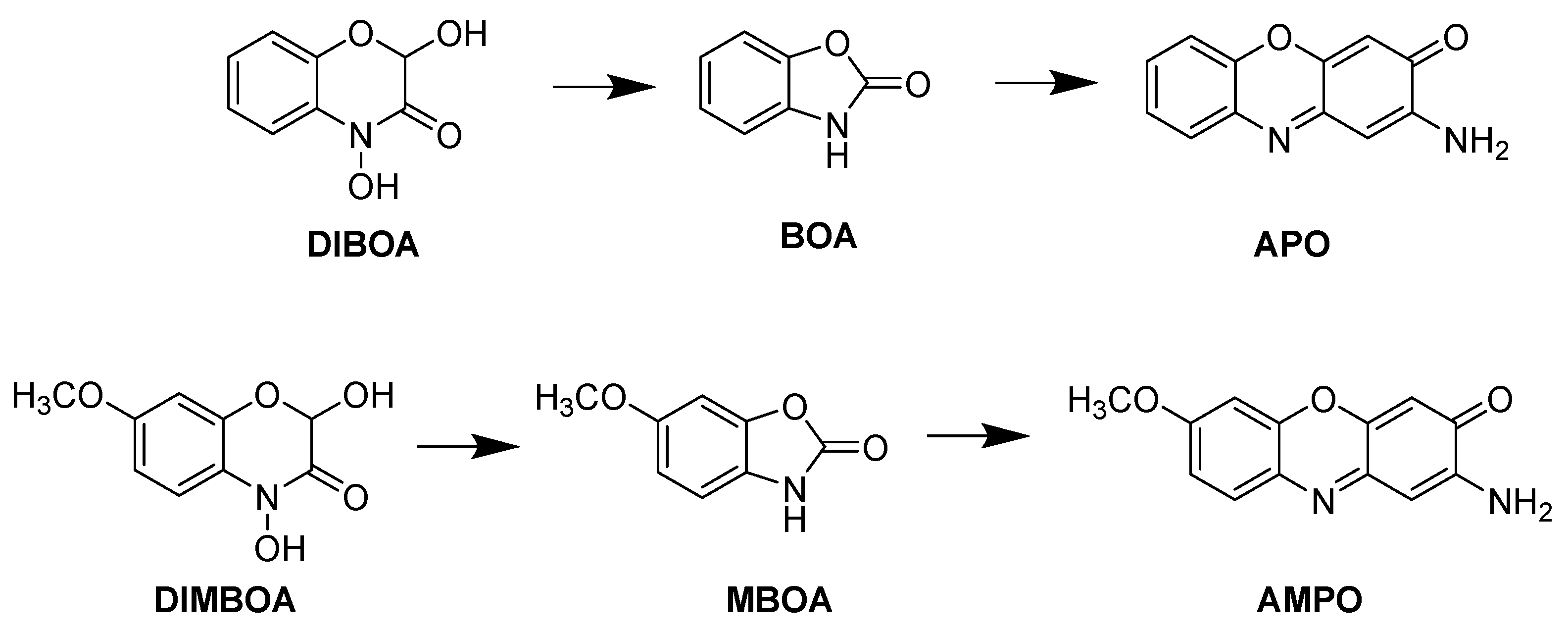

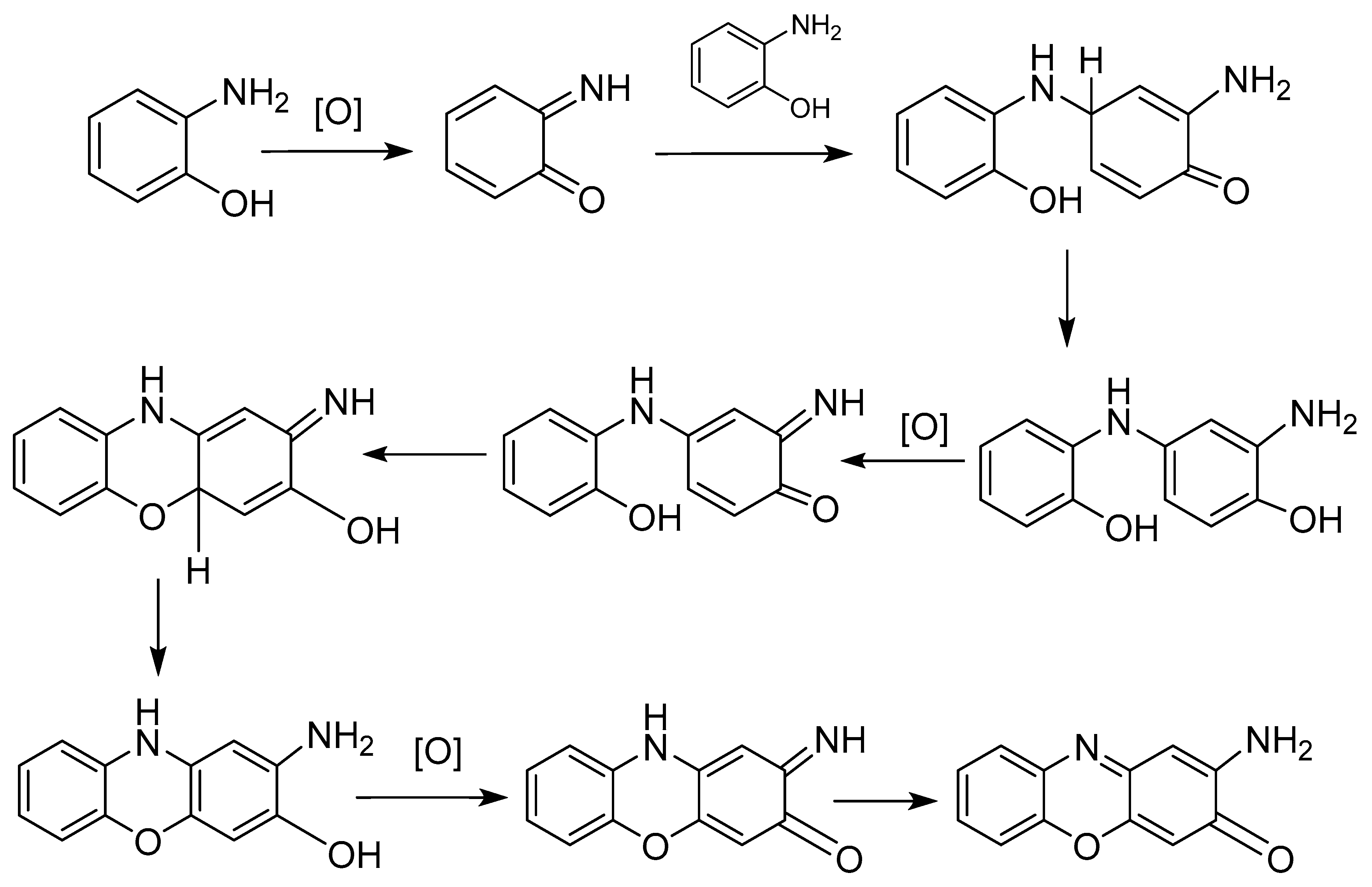
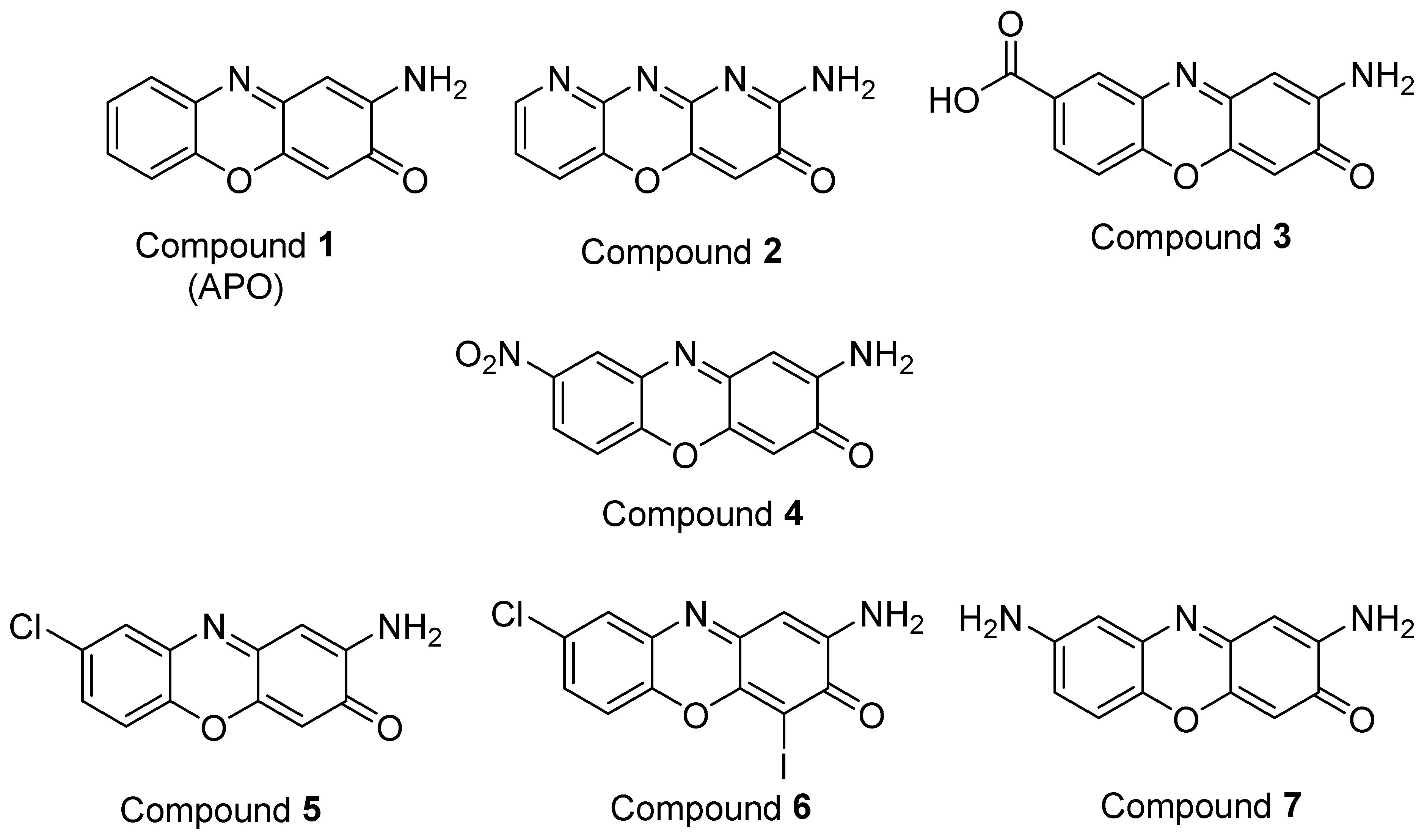

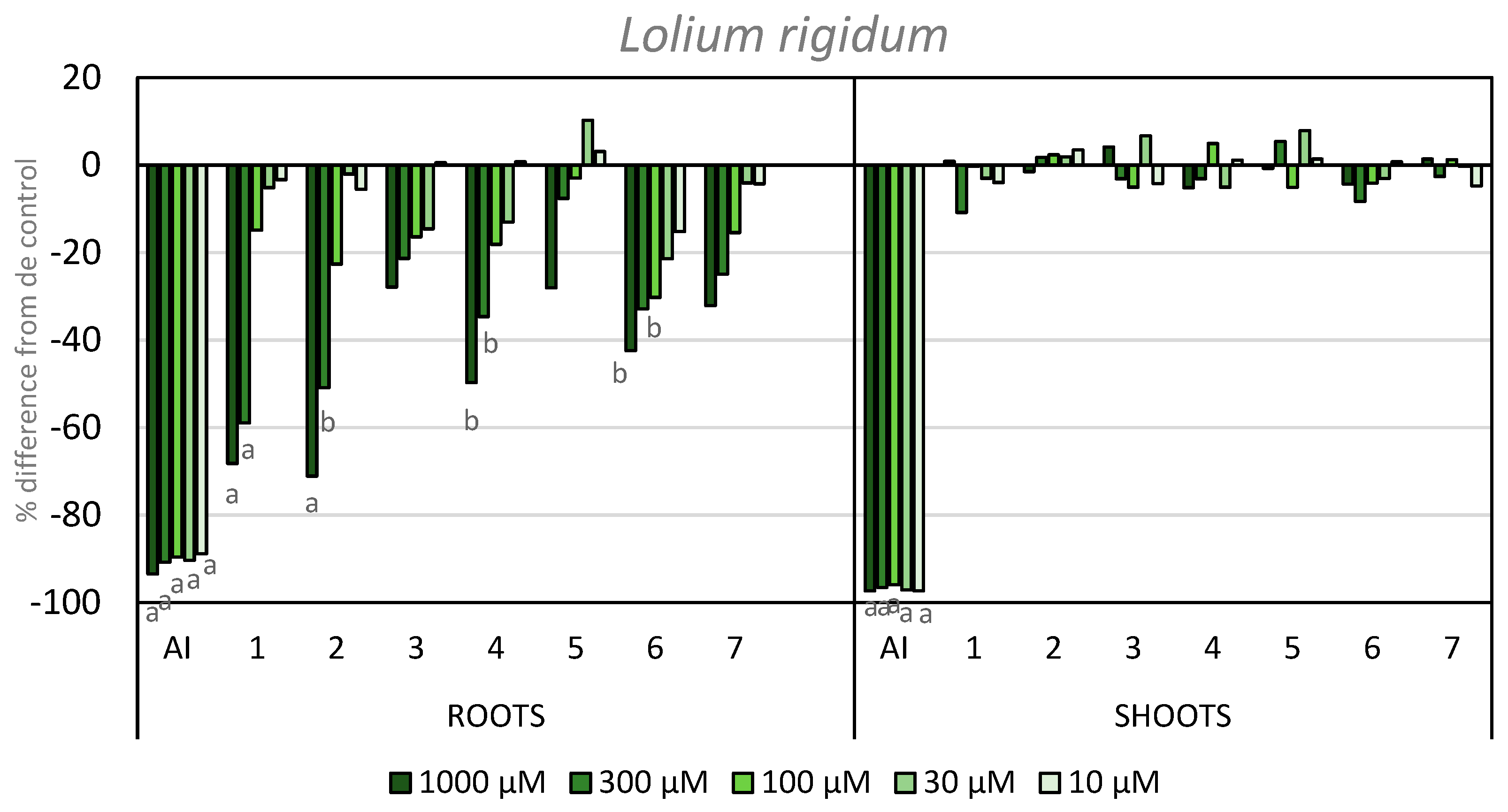
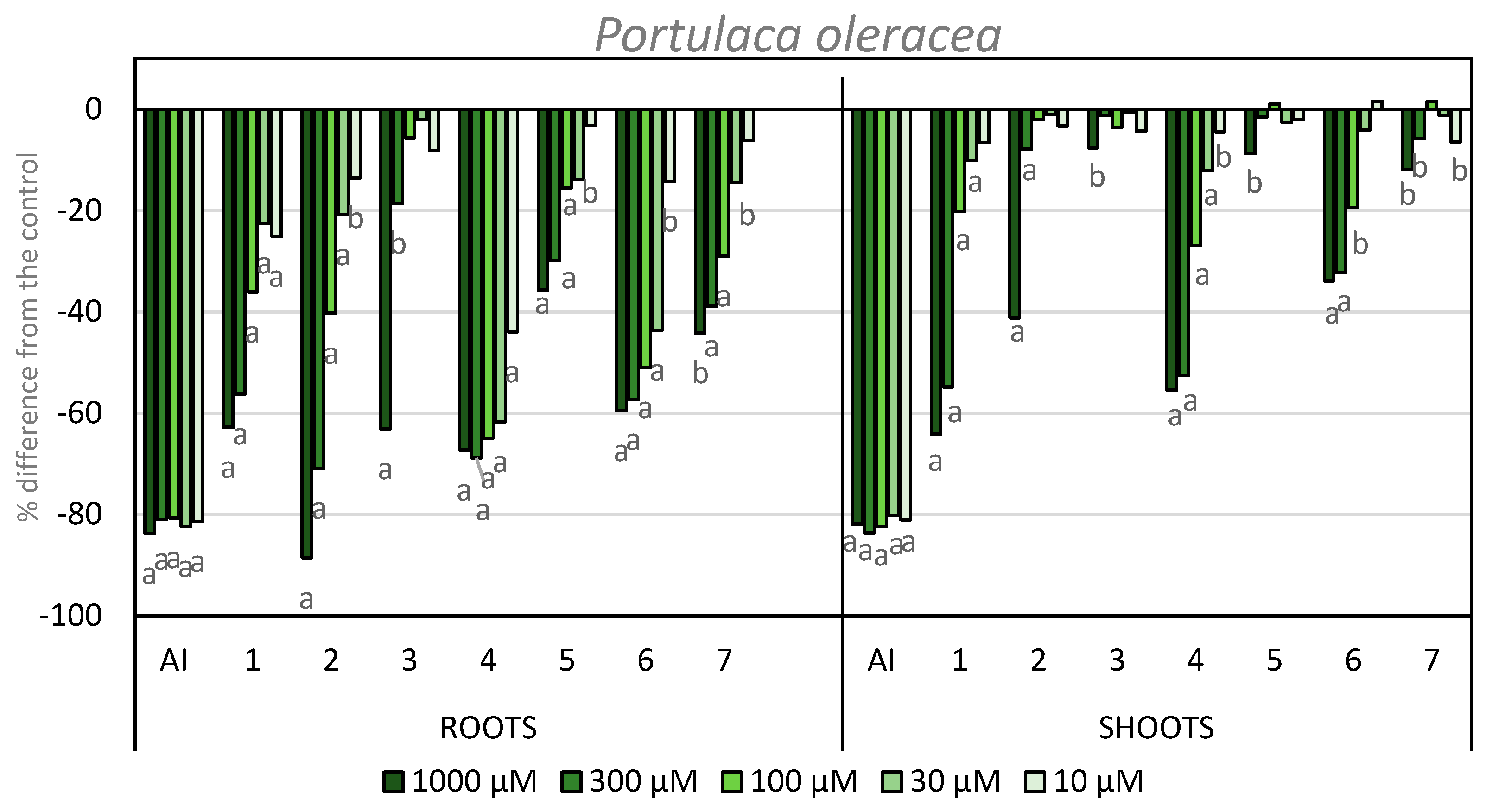
| Compound | IC50 (µM) | R2 |
|---|---|---|
| AI | 1128 | 0.8157 |
| 1 | 219 | 0.9420 |
| 2 | 303.7 | 0.9689 |
| 3 | * | |
| 4 | 857 | 0.9935 |
| 5 | * | |
| 6 | 482 | 0.9845 |
| 7 | * |
Disclaimer/Publisher’s Note: The statements, opinions and data contained in all publications are solely those of the individual author(s) and contributor(s) and not of MDPI and/or the editor(s). MDPI and/or the editor(s) disclaim responsibility for any injury to people or property resulting from any ideas, methods, instructions or products referred to in the content. |
© 2023 by the authors. Licensee MDPI, Basel, Switzerland. This article is an open access article distributed under the terms and conditions of the Creative Commons Attribution (CC BY) license (https://creativecommons.org/licenses/by/4.0/).
Share and Cite
Díaz-Franco, C.; Rial, C.; Molinillo, J.M.G.; Varela, R.M.; Macías, F.A. Synthesis of Aminophenoxazinones and Evaluation of Their Phytotoxicity in the Search for New Natural Herbicides. Agronomy 2023, 13, 568. https://doi.org/10.3390/agronomy13020568
Díaz-Franco C, Rial C, Molinillo JMG, Varela RM, Macías FA. Synthesis of Aminophenoxazinones and Evaluation of Their Phytotoxicity in the Search for New Natural Herbicides. Agronomy. 2023; 13(2):568. https://doi.org/10.3390/agronomy13020568
Chicago/Turabian StyleDíaz-Franco, Cristina, Carlos Rial, José M. G. Molinillo, Rosa M. Varela, and Francisco A. Macías. 2023. "Synthesis of Aminophenoxazinones and Evaluation of Their Phytotoxicity in the Search for New Natural Herbicides" Agronomy 13, no. 2: 568. https://doi.org/10.3390/agronomy13020568
APA StyleDíaz-Franco, C., Rial, C., Molinillo, J. M. G., Varela, R. M., & Macías, F. A. (2023). Synthesis of Aminophenoxazinones and Evaluation of Their Phytotoxicity in the Search for New Natural Herbicides. Agronomy, 13(2), 568. https://doi.org/10.3390/agronomy13020568







